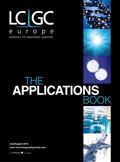Bisphenol A, Octylphenols and Nonylphenol in Drinking Water
The Application Notebook
Bisphenol A (BPA) is widely used in high production volume manufacturing of polycarbonate plastics (for example, food containers and plastic bottles) and epoxy resins.
Leo (Jinyuan) Wang and William C. Schnute, Dionex Corporation, Sunnyvale, California, USA.
Bisphenol A (BPA) is widely used in high production volume manufacturing of polycarbonate plastics (for example, food containers and plastic bottles) and epoxy resins.1 Current studies evaluating the impact of BPA on health and the environment have not reported conclusive results, but actions are being taken proactively to protect sensitive populations. Canada proposed banning BPA to reduce the exposure for newborns and infants in 2009 and the US EPA recently added BPA to its list of target chemicals for possible regulation.1,2 The oestrogenic and toxic effects of octylphenol (OP) and nonylphenol (NP) — degradation products of nonionic surfactants — have been studied and reported.3 Recently, NP has been detected in food and food wraps, posing concerns for food safety and packaging.4,5 The US EPA has regulated NP at 6.6µg/L maximum average level for fresh water.6
Here we describe a high throughput LC–MS method for simultaneous quantitative analysis of BPA, 4-tert-OP, 4-n-OP and 4-NP.
Experimental
Dionex UltiMate 3000 HPLC system with Acclaim PA2 RSLC column (2.1 × 50 mm, 2.2 μm) at 30°C with flow rate of 0.5 mL/min. Gradient mobile phase: methanol/water (75–95% methanol). MSQ Plus mass spectrometer interfaced to system using atmospheric pressure chemical ionization (APCI) source and operated in negative selected ion monitoring mode (SIM): BPA (227 m/z); BPA-IS (241 m/z); 4-t-OP (205 m/z); 4-n-OP (205 m/z); 4-n-NP (219 m/z). Probe temperature: 500°C; corona current: 50µA.
Results and Discussion
BPA, 4-tert-OP, 4-n-OP and 4-n-NP were retained and chromatographically separated within 2.5 min. Potential interferences were also separated chromatographically, as seen in SIM_01 and SIM_02 channels. Figure 1 shows SIM detection at 1 ppb for BPA and 2 ppb for the phenols. Excellent coefficients of determination were achieved for each analyte, with R2 > 0.99, using internal calibration with an isotope labelled internal standard. Method detection limits were statistically calculated and range from 0.032 ppb (BPA) to 0.105 ppb (4-NP).
Analysis of municipal drinking water and seven randomly selected bottled water samples showed no detectable target analytes. Spiked sample analysis showed excellent recoveries: 99.2% for 4-n-NP, 95.6% for BPA, 76% for 4-t-OP and 100.7% for 4-n-OP.

Figure 1: SIM and TIC chromatograms of a bottled water sample spiked with 1 ppb BPA and 2 ppb phenols.
References
1. Bisphenol A Action Plan, US EPA, http://www.epa.gov/opptintr/existingchemicals/pubs/actionplans/bpa.html, accessed April, 2010.
2. Government of Canada Acts to Protect Newborns and Infants from Bisphenol A in Polycarbonate Plastic Baby Bottles, http://hc-sc.gc.ca/ahc-asc/media/nr-cp/_2009/2009_106-eng.php, accessed April, 2010.
3. R. Loos et al., Chemosphere, 66, 690–699 (2007).
4. K. Guenther et al., Environmental Science and Technology, 36, 1676–1680 (2002).
5. A.R. Fernandes, M. Rose and C. Charlton, Food Additives and Contaminants, 25(3), 364–372 (2008).
6. Aquatic Life Ambient Water Criteria: Nonylphenol, US EPA, http://www.regulations.gov/search/Regs/home.html#documentDetail?R=0900006480810c89, accessed April, 2010.
UltiMate and Acclaim are registered trademarks of Dionex Corporation and MSQ Plus is a trademark of Thermo Fisher Scientific Inc.

Dionex Corporation
1228 Titan Way, PO Box 3603, Sunnyvale, California 94088, USA
tel. +1 408 737 0700 fax +1 408 730 9403
Website: www.dionex.com

Separation of Ultra-Short and Long Chain PFAS Compounds Using a Positive Charge Surface Column
December 11th 2024A separation of ultra-short and long chain PFAS (C1-C18) is performed on a HALO®PCS Phenyl-Hexyl column along with a HALO®PFAS Delay column which demonstrates excellent retention for both hydrophilic and hydrophobic analytes.

.png&w=3840&q=75)

.png&w=3840&q=75)



.png&w=3840&q=75)



.png&w=3840&q=75)













